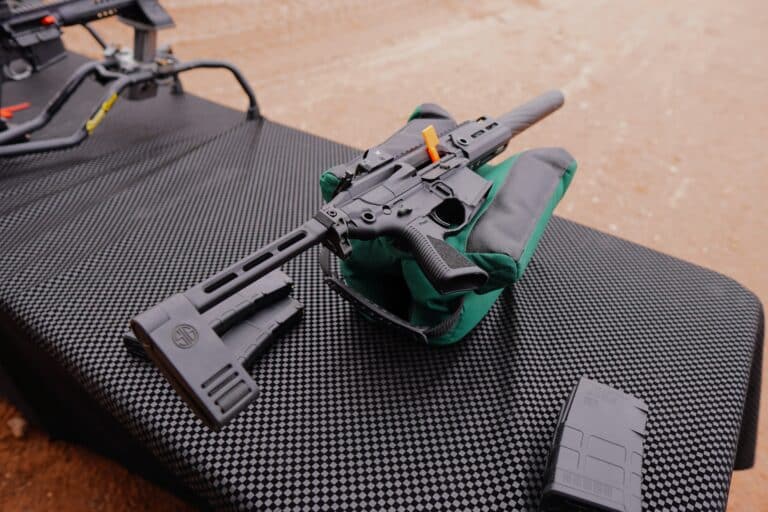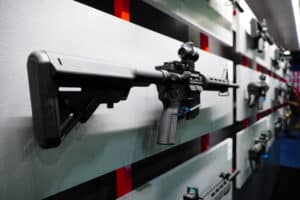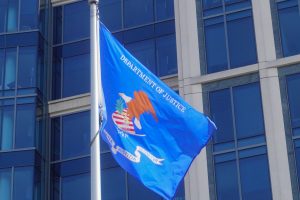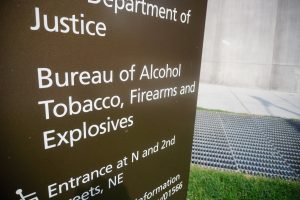The ATF’s ban on pistol-brace-equipped firearms has hit another wall in court.
On Friday, a panel on the Eighth Circuit Court of Appeals ruled two-to-one that the agency violated the Administrative Procedure Act (APA) when trying to reclassify the guns. The majority found the rule, imposed at the request of President Joe Biden, exceeded the ATF’s authority under federal law. It determined the agency’s rule was simply too vague to stand.
“[T]he Final Rule makes it ‘nigh impossible for a regular citizen to determine what constitutes a braced pistol, and … whether a specified braced pistol requires NFA registration,'” Judge L. Steven Grasz wrote for the majority in FRAC v. Garland. “For those reasons, the Final Rule is arbitrary and capricious.”
The ruling puts the ATF and Biden Administration further on the back foot when it comes to their effort to expand gun restrictions through unilateral federal lawmaking. The brace ban, which potentially impacts millions of American gun owners, has already been blocked by several other federal courts in the year and a half since it was adopted. The brace ban’s prospects were further dashed when the bump stock ban, which was implemented under the Trump Administration via similar federal rulemaking, was struck down by the Supreme Court in June’s Cargill v. Garland.
Judge Grasz specifically referenced that Supreme Court decision in his opinion. He argued the same standard of review should apply in both cases.
“The Supreme Court clearly treated the ATF interpretive rule as a final agency action because the Court held the ATF exceeded its statutory authority and affirmed the Fifth Circuit’s judgment against the ATF,” Judge Grasz, a Donald Trump appointee, wrote. “It was true in Cargill and it is true here: the Final Rule is a final agency action subject to judicial review.”
The legal fight began after the ATF officially announced its rule back in January 2023. Despite classifying pistol braces as unregulated accessories for nearly a decade beforehand, the new rule reclassified nearly all pistol-brace-equipped firearms with a barrel under 16 inches long as short-barrel rifles. That made them subject to the National Firearms Act (NRA) of 1934, which required owners to either register, dismantle, or destroy the affected guns if they didn’t want to face felony charges.
Judge Grasz noted the scope of the regulation and its potential consequences were very serious.
“Though the Final Rule does not ban stabilizing braces or braced weapons that are ‘short-barreled rifles,’ the consequences of possessing a braced weapon deemed to be a ‘short-barreled rifle’ are dire: that firearm and the person who possesses it are subject to the NFA’s and GCA’s stringent regulations and serious criminal penalties for non-compliance,” he wrote. “Considering the ATF estimated that by 2020 there were, at the low end, three million stabilizing braces in circulation (with seven million at the high end) plus an untold number of stabilizing braces sold between 2020 and the Final Rule’s publication in January 2023, then the Final Rule does the job of reclassifying these millions of braced weapons—and those who possess them—as violating the NFA and GCA.”
Attorney General Merrick Garland (D.) defended the change at the time as necessary to stop what he claimed were people circumventing the law.
“Keeping our communities safe from gun violence is among the Department’s highest priorities,” he said in a statement. “Almost a century ago, Congress determined that short-barreled rifles must be subject to heightened requirements. Today’s rule makes clear that firearm manufacturers, dealers, and individuals cannot evade these important public safety protections simply by adding accessories to pistols that transform them into short-barreled rifles.”
Still, few owners actually registered their firearms. The ATF told The Reload it had received 255,162 registration applications before the May 2023 deadline for compliance. It’s not clear how many braced guns were in civilian hands by that point, though. The ATF estimated in its impact assessment three to seven million devices were in circulation. However, the Congressional Research Service estimated there were somewhere between 10 and 40 million.
Those numbers put the compliance rate somewhere between 0.6 percent and eight percent.
Gun-rights advocates challenged the rule change in several federal circuits. Shortly after it went into effect, multiple federal judges issued preliminary injunctions against the rule. In August 2023, a Fifth Circuit Court of Appeals panel ruled in Mock v. Garland that it was “unlawful” under the APA. That panel then remanded the case to US District Judge Reed O’Connor, who found in October 2023 that the rule violates the Second Amendment.
“[T]he Court finds that the Government Defendants’ implementation and enforcement of the Final Rule substantially threatens to inflict irreparable constitutional harm upon the [Firearms Policy Coalition] members,” Judge O’Connor, a George W. Bush appointee, wrote in Mock v. Garland. “Absent injunctive relief, the Final Rule will impair and threaten to deprive them of their fundamental right to keep and bear commonly used arms as a means of achieving the inherently lawful ends of self-defense. See U.S. CONST. AMEND. II (providing that the ‘right of the people to keep and bear Arms, shall not be infringed.’).”
Friday’s ruling focused entirely on the APA claims. Judge Grasz zeroed in on the “amorphous” way the ATF tried to define which braced guns are covered under the rule. He examined each of the individual standards the agency said it used in a multi-prong test to make that determination.
“Not only are these terms vague (who comprises this ‘general community’ and how will the ATF evaluate them?), but the community-use factor relies on circular reasoning: ‘the likely use of the weapon by the general community’ is determined by its ‘use . . . in the general community.'” Judge Grasz said. “That tells the reader nothing about how the ATF will evaluate community use under the Final Rule, allowing the ATF to reach any decision it wishes by only looking to specific evidence of community misuse, while ignoring any other examples of the community’s compliant use.”
He rejected the ATF’s argument that it needed to keep its standards loose to keep bad actors from circumventing them.
“That the regulated parties wish to see more specific metrics does not mean they wish to skirt or circumvent the law, as ATF insinuates,” Judge Grasz wrote. “They may simply wish to comply with the law, by producing or equipping stabilizing braces that do not have a rear surface area that allows for shoulder firing a weapon.”
He also shot down the agency’s promise to follow up its initial rule with further guidance on how to comply later on down the line.
“The ATF claims that it fully intends to ‘follow up’ the Slideshows with ‘detailed classification letters explaining each determination,’ and that any remedy for improper agency action would simply be to ‘remand any unexplained conclusions to the agency for further explanation or reconsideration,'” Judge Grasz wrote. “This is much like shooting the side of a barn, drawing the target around the bullet holes, and then proclaiming, ‘bullseye!’ Agency actions require ‘contemporaneous explanations,’ and not just post hoc justifications ‘raised in court by those appearing on behalf of the agency or by agency officials themselves.’ The ATF’sact-now-and-justify-later decisionmaking is exactly the kind of post hoc rationalizing that cannot sustain its unexplained actions.”
The case was brought by a coalition of gun companies, individuals, and 25 state Attorneys General. SB Tactical, the originator of the pistol brace, and the Firearms Regulatory Accountability Coalition (FRAC), a trade group, celebrated the decision.
“This ruling is significant because it is the first federal appeals court to directly attack the open ended and subjective factors put forth in the rule,” Mike Faucette, a lawyer for the plaintiffs, told The Reload. “These factors are no different than a local government posting a speed limit prohibiting people from driving ‘too fast’ but refusing to inform drivers of an actual number. The regulated industry and gun owners deserve to have fair notice of what is expected of them–especially when the consequence for being wrong is jail time.”
FRAC argued the ruling represented a further defeat of the rule.
“While the federal court in Texas has already vacated the Brace Rule, this ruling expands upon that by denying ATF’s ability to issue vague and amorphous standards that allow it to reach any outcome it wants,” Travis White, the group’s president, said in a statement. “This published federal appellate court ruling will serve to hold ATF accountable in future attempts by the agency to invent subjective factors that allow it to apply post hoc reasoning in classification letters and rules.”
The Department of Justice, which is defending the ATF’s rule, did not respond to a request for comment.
Judge Bobby Shepherd dissented from the majority, but only on the grounds it was unecessary to examine the rule at all because the Mock decision already vacated it.
“[H]ere, no party suggests that the Government will enforce the Final Rule against the Coalition despite its vacatur,” Judge Shepherd, a George W. Bush appointee, wrote. “No party points to injuries that the Coalition will suffer without a preliminary injunction now that the Final Rule has been vacated. Nor does the Coalition seek an injunction preventing the ATF from pursuing future regulation of braced-pistols apart from the Final Rule.”
However, the majority argued the rule being vacated did not necessairly mean the plaintiffs had gotten the relief they needed. So, it sent the case back down to the district judge to determine what relief might still be required.






